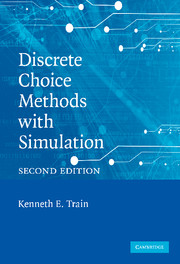2 - Properties of Discrete Choice Models
Published online by Cambridge University Press: 05 June 2012
Summary
Overview
This chapter describes the features that are common to all discrete choice models. We start by discussing the choice set, which is the set of options that are available to the decision maker. We then define choice probabilities and derive them from utility-maximizing behavior. The most prominent types of discrete choice models, namely logit, generalized extreme value (GEV), probit, and mixed logit, are introduced and compared within the context of this general derivation. Utility, as a constructed measure of well-being, has no natural level or scale. This fact has important implications for the specification and normalization of discrete choice models, which we explore. We then show how individual-level models are aggregated to obtain market-level predictions, and how the models are used for forecasting over time.
The Choice Set
Discrete choice models describe decision makers' choices among alternatives. The decision makers can be people, households, firms, or any other decision-making unit, and the alternatives might represent competing products, courses of action, or any other options or items over which choices must be made. To fit within a discrete choice framework, the set of alternatives, called the choice set, needs to exhibit three characteristics. First, the alternatives must be mutually exclusive from the decision maker's perspective. Choosing one alternative necessarily implies not choosing any of the other alternatives. The decision maker chooses only one alternative from the choice set. Second, the choice set must be exhaustive, in that all possible alternatives are included.
Information
- Type
- Chapter
- Information
- Discrete Choice Methods with Simulation , pp. 11 - 33Publisher: Cambridge University PressPrint publication year: 2009
Accessibility standard: Unknown
- 2
- Cited by
